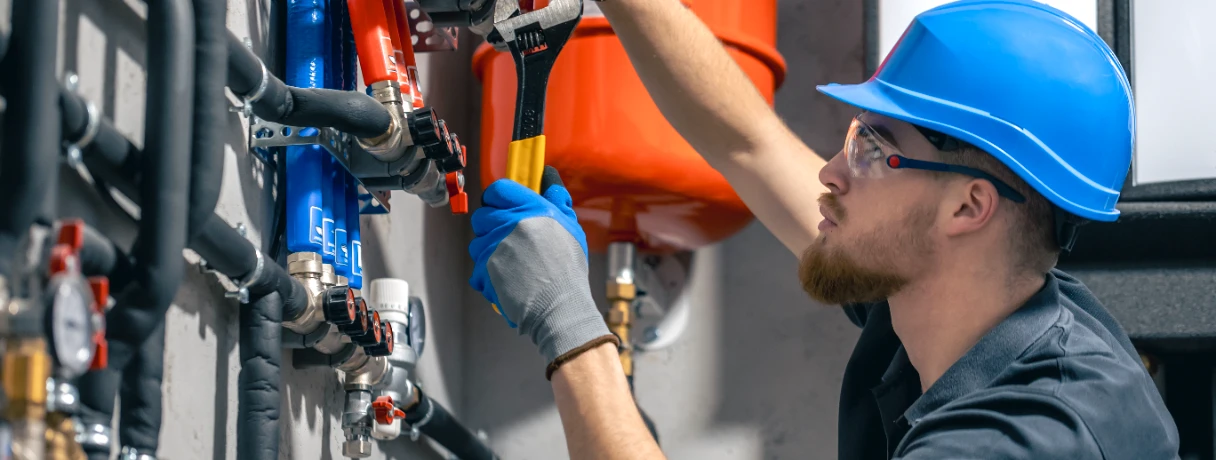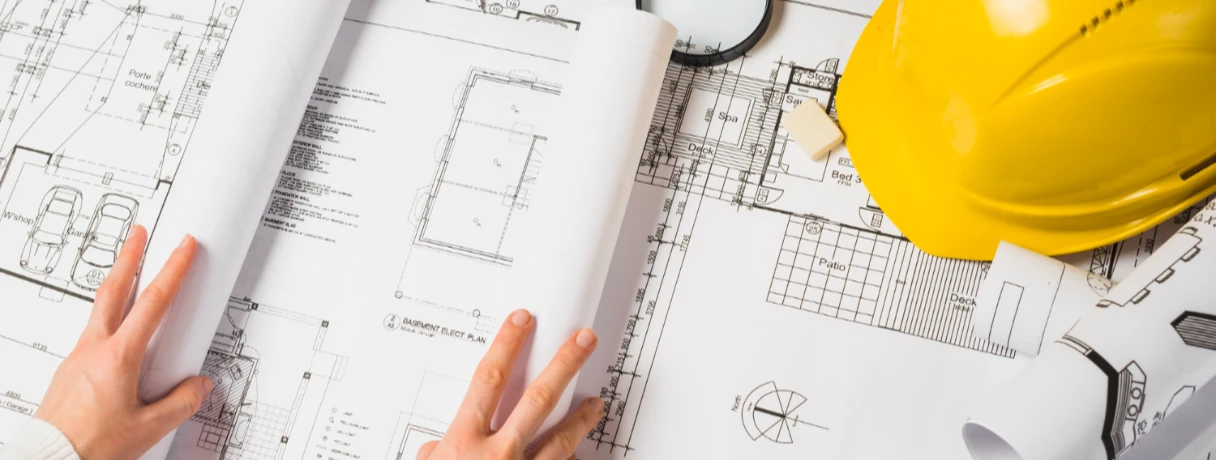Accurate HVAC takeoffs are crucial for successful bids. They reduce waste, save costs, and improve project efficiency. This HVAC takeoff guide breaks down the process, highlights key considerations, and explains how AI-powered tools like Beam AI make HVAC quantity takeoff faster and error-free.
What is an HVAC takeoff?
HVAC takeoff can mean:
1. A physical component: A small collar or branch connector that links smaller ducts to main lines, distributing airflow efficiently.
2. A process in estimating: Measuring and listing all materials, components, and equipment needed for HVAC installations using construction blueprints.
It includes ducts, pipes, equipment, and accessories, providing a precise foundation for installation planning and bids.

Why Accurate HVAC Takeoffs Matter
Accurate HVAC takeoffs are essential because they form the backbone of effective project planning, budgeting, and execution. Even small mistakes at this stage can ripple through the entire project - causing cost overruns, schedule delays, and installation errors. Poorly estimated takeoffs can also affect system performance, leading to reduced energy efficiency and long-term operational issues. In short, precision in HVAC takeoffs ensures smoother construction, better cost control, and reliable system performance. In short, accurate HVAC takeoffs ensure:
- Correct material procurement.
- Avoiding costly rework, delays, and budget overruns.
- Precise foundation for successful bids and project execution.
Key Components of HVAC Takeoffs
- Ductwork: Measure length, width, height, diameter, and material.
- Equipment: Specify capacities and types like air handling units.
- Accessories: Include vents, grilles, hangers, dampers, and diffusers.

Key Considerations in HVAC Quantity Takeoff
Key considerations for an HVAC quantity takeoff include thoroughly analyzing project documents like blueprints and specifications, accurately quantifying all materials; such as ductwork, piping, equipment, and accessories-and factoring in waste allowances and specific material gauges. Estimators should also account for labor costs and, whenever possible, use BIM support or HVAC takeoff software to boost efficiency and precision. Paying close attention to these details helps prevent costly overruns, supports accurate budgeting, and ensures smooth resource planning throughout the project. Broadly, the items to keep in mind are:
- Ductwork Types & Measurements
- Understand the specific measurement needs for rectangular, round, spiral, and flexible ducts.
- Include size, shape, material thickness, and length.
- Fittings & Accessories
- Account for elbows, tees, reducers, dampers, diffusers, grilles, and registers.
- Quantity based on project drawings and layout.
- Damper and Control Needs
- Estimate number, size, and location of volume, fire, and smoke dampers.
- Insulation Requirements
- Measure type, thickness, and coverage for duct and equipment insulation to meet codes and improve energy efficiency.

The HVAC Takeoff Process Simplified
Let’s see the broad steps followed by estimating teams to conduct the HVAC takeoff process:
- Gathering Information
- Review architectural drawings and project specs to understand the project scope.
- Collect data on materials, equipment, control systems, and compliance standards.
- Identifying and Quantifying Components
- Calculate quantities of ductwork, pipes, equipment, and accessories. For this step, estimators can leverage takeoff software.
- Estimating teams are shifting from digital tracing tools to AI-based takeoff software for calculating ductwork lengths and material quantities.
- Beam AI automates takeoffs with 99.5+% accuracy, dramatically saving time and improving precision.
How to Choose the Right HVAC Takeoff Software

Choosing the right HVAC takeoff software starts with understanding your company’s needs and matching them with the right set of tools and features. Here’s a breakdown of what to consider before investing:
1. Assess Your Needs
- Company Size and Scope: Determine whether you need a comprehensive all-in-one platform or a specialized HVAC takeoff solution tailored for your trade.
- Project Complexity: If you handle mostly residential work, a simple tool may be enough-but for large commercial projects, look for advanced capabilities like automated fitting detection, complex duct layout handling, and support for simultaneous takeoffs.
- Budget and Pricing Model: Evaluate how the software is priced-per user, per project, or via subscription tiers-and make sure it fits your budget and project volume.
2. Ease of Use
- User-Friendly Interface: An intuitive layout and customizable workflows help your team adopt the tool quickly.
- Training Resources: Look for platforms that provide in-app tutorials, templates, and helpful onboarding materials for a smooth learning curve.
3. Features and Functionality
- AI Automation: Fully automated or AI-assisted takeoff software can save hours by automatically identifying HVAC components, calculating dimensions, and generating quantities directly from blueprints.
- Integration: The software should easily integrate with your estimating, accounting, CRM, or project management tools, creating a seamless workflow across departments.
- Plan Import & Measurement Tools: Ensure it supports common file formats (like PDF and CAD) and offers precise digital measurement and tracing capabilities.
- Customization: Look for flexible settings that let you adjust labor rates, material markups, and pricing models based on your company standards.
- Reporting & Analytics: Robust reporting helps track job costs, margins, and estimator performance in real time.
4. Mobility and Collaboration
- Cloud-Based Access: Cloud collaboration lets multiple team members work on the same project simultaneously and access updates in real time.
- Mobile Access: Estimators and field teams can review or update takeoffs on-site, helping speed up approvals and communication.
5. Cost and Licensing
- Weigh the software’s cost against its potential to save labor hours and improve bid accuracy. Consider whether a subscription model or perpetual license better suits your long-term needs.
6. User Feedback and Reviews
- Before making a final decision, check industry forums, peer referrals, and user reviews to learn how the software performs in real-world scenarios-especially in terms of accuracy, support, and ease of integration.
Why AI-Powered HVAC Takeoffs Are a Game-Changer
AI-powered HVAC takeoffs are transforming how contractors estimate materials and labor. By automating what used to be a time-consuming, manual process, AI helps teams improve accuracy, cut costs, and work far more efficiently. Instead of spending hours on blueprints and spreadsheets, estimators can now generate detailed, error-free takeoffs in a fraction of the time.
Here’s why this technology is such a game-changer for HVAC professionals:
1. Increased Accuracy and Precision
- Machine Learning for Smarter Estimations: AI continuously learns from past projects, improving the accuracy of heat load calculations, duct sizing, and component selection with every new estimate.
- Automated Data Analysis: Instead of manually measuring drawings, AI quickly processes digital floor plans and building specs, extracting the information needed for precise takeoffs.
- Reduced Human Error: Automation eliminates the small miscalculations and missed items that can throw off manual estimates, ensuring far more reliable numbers from the start.
2. Significant Cost and Time Savings
- Faster Takeoffs: AI handles repetitive and time-intensive tasks in minutes-what used to take hours or even days.
- Optimized Material Ordering: More accurate measurements mean you order exactly what’s needed-no more over-purchasing or last-minute shortages.
- Fewer Design Revisions: When takeoffs are done right the first time, you avoid costly rework and design changes during installation.
3. Enhanced Efficiency and Productivity
- Automated Workflows: AI streamlines routine tasks, giving engineers and estimators time to focus on higher-value work-like improving system design or strategizing for bids.
- Smarter Project Management: With AI-generated insights, teams can allocate resources better, manage labor more effectively, and keep HVAC projects running smoothly from start to finish.
4. Improved System Performance
- Better System Sizing: Accurate takeoffs lead to properly sized HVAC systems-resulting in improved energy efficiency, reduced operating costs, and greater occupant comfort.
In short, AI-powered HVAC takeoff software doesn’t just make estimating faster-it elevates every aspect of the process, from planning and procurement to performance and profitability:
- AI tools like Beam AI process multiple HVAC takeoffs in parallel-a major boost over manual methods.
- Automates the extraction of quantities from digital plans, reviewed by expert QA teams to ensure ±1% accuracy.
- Cuts takeoff effort by up to 90%, helping estimators focus on strategic tasks like procurement optimization and value engineering.
The Final Word
Accurate HVAC takeoffs are foundational to successful projects and with AI-based HVAC takeoff software such as Beam AI, estimators can now focus on winning more bids and delivering projects confidently. Read how MGT Enterprises doubled their bid output with Beam AI here.
Leveraging Beam AI saves time, minimizes errors, and streamlines HVAC quantity takeoffs, estimators can unlock the free Beam AI experience here.

.png)












.webp)

